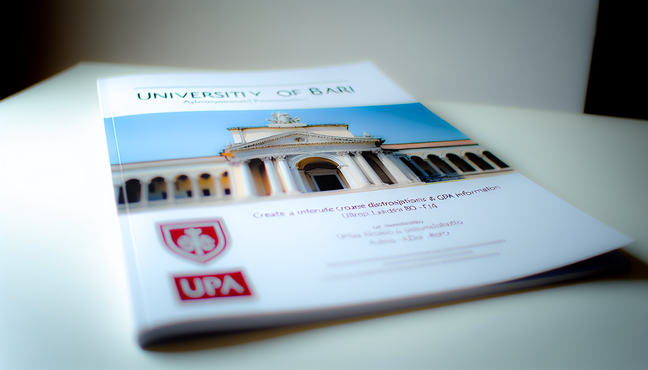Introduction to the University of Bari Aldo Moro
The University of Bari Aldo Moro, founded in 1925, stands as one of Italy’s most respected educational institutions, renowned for its commitment to academic excellence and research. Named after the notable Italian statesman Aldo Moro, it has transformed its historic roots into a modern hub for scholarship, innovation, and cultural exchange.
Located in Bari, the university serves a diverse student body and offers a broad range of undergraduate and postgraduate programs across multiple disciplines, including humanities, sciences, and social sciences. The university prides itself on its rigorous academic standards, attracting ambitious scholars from Italy and around the globe. The campus is equipped with state-of-the-art facilities, including laboratories, libraries, and collaborative spaces that enhance the educational experience. Furthermore, the university’s integration into the local community fosters a vibrant atmosphere, where students can engage in various cultural and social activities.
With a strong emphasis on research, the University of Bari Aldo Moro collaborates with international institutions, ensuring that its academic offerings are aligned with global standards. This focus on innovation and collaboration positions it as a key player in the evolution of higher education in Italy and beyond. For more information, visit the official website of the university or explore detailed course descriptions available at Course Description.
Understanding Course Descriptions and Syllabi
Course descriptions and syllabi serve as essential tools for applicants navigating their educational journeys. A course description provides a succinct overview of the content, objectives, and requirements, allowing prospective students to assess whether it aligns with their interests and career goals. It often includes prerequisites, which can help ensure that students are adequately prepared for the material they will encounter.
In addition to course descriptions, syllabi offer a more detailed roadmap of the course structure, including topics covered, required readings, assignment deadlines, and grading policies. This clarity can enhance a student’s ability to manage their time effectively and prioritize assignments, ultimately contributing to a more organized approach to their studies. Syllabi also often outline the instructor’s expectations and the methods of evaluation, giving students insight into how their performance will be assessed, which can reduce anxiety surrounding coursework.
Understanding these documents allows students to make informed choices about which courses to take, ensuring alignment with their long-term academic and professional aspirations. Investing time to read and comprehend course descriptions and syllabi is a strategic step in navigating the educational landscape and can significantly impact the quality of the learning experience. For additional resources on understanding academic materials, visit Course Description.
GPA and ECTS Explained
GPA (Grade Point Average) and ECTS (European Credit Transfer and Accumulation System) are essential metrics used to evaluate academic performance and course workloads in educational institutions worldwide. GPA is a numerical representation of a student’s academic performance, typically calculated on a scale of 0.0 to 4.0, where each letter grade corresponds to a specific point value. For instance, an ‘A’ might be valued at 4.0, a ‘B’ at 3.0, and so forth. Colleges and universities use GPA as a standard method to assess a student’s understanding of the material, performance in individual courses, and overall academic success. High GPAs often play a crucial role in admissions for advanced education and determining scholarships [Source: The Balance Careers].
In contrast, ECTS is primarily used in Europe, designed to facilitate the transfer of credits between institutions and promote student mobility. One academic year is typically equivalent to 60 ECTS credits, which breaks down to about 30 ECTS per semester. This system allows students to accumulate credits for the courses they complete, thereby standardizing the credit allocation across different countries and educational systems. ECTS focuses on learning outcomes and workload, enabling students to reflect not just on time spent in class but also on the effort required to achieve certain learning outcomes [Source: European Commission].
Both GPA and ECTS serve critical roles in the global education landscape; GPA primarily functions within the North American system, while ECTS is predominant in European institutions. Understanding the nuances of these systems is vital for students navigating international education, whether they are transferring credits or applying for institutions across the globe. For more insights on the intricacies of educational systems and credit transfers, explore our detailed guides on academic grading systems and how ECTS works.
Accessing Course Information
To access certified course descriptions, syllabi, and GPA/ECTS information for your desired programs at the University of Bari Aldo Moro, follow these step-by-step instructions:
- Visit the University Website: Start by navigating to the official University of Bari Aldo Moro website. Look for the Academic section or specific program pages relevant to your study area.
- Choose Your Program: Once on the website, find the program you are interested in. Programs are typically organized by faculty, so make sure to select the correct one for your field of study.
- Locate Course Information: Within your chosen program page, look for links or tabs labeled “Course Information,” “Course Descriptions,” or “Syllabi.” This section should provide a comprehensive list of all the courses offered.
- Download Course Descriptions: Most course descriptions will be available for download in PDF format. Click on the provided link or button to download the documents directly to your device for offline access.
- Access Syllabi and Other Resources: For course syllabi and additional information such as GPA/ECTS details, continue exploring the program page or check if there is a dedicated section for current students. Some resources may require student login credentials, so ensure you have your account details handy.
- Check External Databases: If the information is not available on the university’s website, consider visiting external educational resources such as Course-Description.com, which may also provide comprehensive details and access to various course information databases.
Following these steps will help ensure you have all necessary course information readily accessible for your studies at the University of Bari Aldo Moro.
Tips for Prospective Students
Navigating the application process can be daunting, but with the right strategies, prospective students can enhance their chances of success. Here are essential tips to help you make the most out of your application journey:
- Research Programs Thoroughly: Before applying, ensure you understand the specifics of each program. Consider factors such as course content, faculty expertise, and graduate outcomes. Use resources like Course Description to gain insights into curriculum details.
- Tailor Your Academic Plan: Align your course selections with your career goals. If you’re unsure about your path, consider taking foundational courses in areas of interest. This flexibility allows you to explore options while ensuring that your final selection is strategic.
- Showcase Relevant Experiences: Highlight extracurricular activities, internships, or volunteer work that align with your desired field of study. Admissions committees value practical experiences that demonstrate your commitment and readiness for the program.
- Engage with Current Students and Alumni: Networking with those who have first-hand experience can provide invaluable insights. Reach out through social media platforms or attend university open days to ask about their experiences and advice.
- Craft a Personalized Statement of Purpose: Your statement should not only reflect your academic achievements but also your passion for the field. Explain why you’re drawn to that particular program and how it aligns with your future aspirations, using concrete examples to illustrate your points.
By implementing these strategies, you can navigate the application process with greater confidence and clarity, increasing your chances of gaining admission to your desired program.










